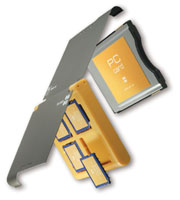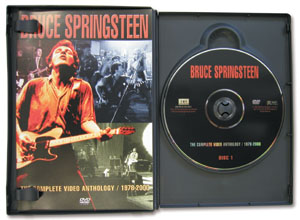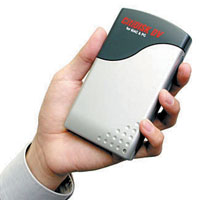The Pulse 2
Back to Contents of Issue: July 2003
|
|
|
|
|
|
 Elecom Shelspia II
IF YOU'RE A BUSINESSMAN out to impress, forget all about your shiny metal meishi (business card) holders from Muji and feast your eyes on the Shelspia II hard cases for your mini flash Ram cards from Elecom. Holding from two to six cards, the cases are all made out of aluminum (rugged) with soft plastic inlay trays (safe) in different colors (revolting). There are hard cases to suit all portable memory storage or power needs, including ones for the new XD Picture card format, a Type II PC card, Smart Media, SD and Compact Flash cards, Sony Memory Sticks and even good ol' plain vanilla batteries. We all know what a pain and, frankly, how embarrassing; it is to be caught out in polite society without a vessel in which to store your memory, so now you have a choice. Priced from JPY800 and out since the end of May, here's our advice: Vote Elecom.
More info: www.elecom.co.jp/news/200305/shelspia2/index.html
Sony PSX
LAST MONTH'S GLITZY LAUNCH of Sony's PSX home entertainment machine posed a good deal more questions than it answered. The whole event needs to be put in its proper context.
What we have seen of this device could indeed usher in a new era of all-encompassing systems -- Sony has the massive weight of history on its side in this regard. But it is important to remember that it comes at a time when Sony, the world's largest consumer electronics company, is on the ropes. For all the excitement over the PSX, there is little to disguise the fact that Sony is pinning desperate revival hopes on this "epoch-making" home entertainment system.
The device, was unveiled in late May as the centerpiece of the company's annual strategy presentation -- an event that came just one month after a disastrous set of full-year results that sent the stock crashing 25 percent to the depths of a seven-year low.
Sony's showmanship was excellent. Around 600 journalists were summoned to the strategy presentation and listened to chairman Nobuyuki Idei explaining how his company was going to beat the rot. But it was impossible to ignore the pedestal over to the other side of the stage covered in a white sheet. The press pack glazed over as they imagined the wonders lurking beneath. The honor of pulling it off went to Ken Kutaragi -- the genius who made the PlayStation the global success it was.
But despite the well-managed drama of the product launch, the meeting was a disappointment to many investors who had hoped that the company would supply more details of its critical restructuring program. Although the company spoke about major cost-cutting efforts and job cuts, it also said it would leave many of the details to a later date.
The PSX itself was a cause for alarm among some investors. Tim Fairweather, a Tokyo-based hedge-fund manager, said: "It looks cobbled together for this occasion, and to give the impression that the company has a serious pipeline of new products."
At its April statement to the market, Sony announced operating profits almost JPY100 billion short of the forecast issued by management just two months earlier. Its outlook statement was even more bleak, with a prediction that operating profits in fiscal 2003 would slide to a nine-year low.
Sony, which will soon be celebrating its 60th birthday, has for many come to represent a major part of the Japanese economy -- a fact that Idei makes frequent reference to. In the aftermath of the April results, the spectre of the iconic high-tech pioneer falling on hard times created panic in the market. The Nikkei 225 index fell to a post-bubble low on the "Sony Shock."
After the April results, Sony promised a massive JPY1.3 trillion restructuring process that would entail moving some manufacturing out of Japan, and a hefty JPY500 billion investment in its semiconductor business. The group then added the information that it would be concentrating on high-growth product areas such as flat-screen TVs, recordable DVD players and camcorders. Sony hinted that a lot of this activity could be at the expense of the old cathode ray tube TV business, which analysts have touted as an obvious candidate for dropping entirely.
Kutaragi's role in the presentation was to do what Sony has always done best -- to triumphantly reveal a machine billed as a future industry standard. History is very much on his side: It was at precisely these meetings that the Walkman, CD player and original PlayStation were unveiled for the first time.
The thinking behind the PSX, which should be on American shelves early next year, is to package into one sleek box a series of machines that Sony believes will one day be perched near every TV in the world anyway. By basing the whole device on a PlayStation2, the chief functions will already be familiar in 52 million households across the globe. By including a digital decoder, Sony hopes that people will decide to invest in the PSX instead of a separate set-top box.
The launch of the PSX is the second time in four weeks that Sony has used word of a new product to win back investor goodwill. Just days after the "Sony Shock," Kutaragi unveiled plans for a portable version of the PlayStation that is designed to challenge Nintendo's dominance of the lucrative hand-held games market.
THE CITIDISK IS A portable storage widget that will take a DV stream directly from a digital camcorder and lay it down on the hard disk using an IEEE 1394 (firewire) connection. A clever idea when you consider how fiddly the process is now. Basically, the idea is that you get it straight to your hard disk rather than recording it onto miniDV tape first, buying a video capture card and transferring it over to the HD on your computer. Makes sense, I suppose. Or does it? Doesn't it just mean that you're buying this instead of a capture card? And wouldn't a capture card be cheaper? A little bit of shopping around will probably yield good results on that score, if you're prepared to invest the time.
Anyhow, the CitiDisk comes in 20, 40 or 60-gig hard-disk configurations and owners can store recordings for up to 80 minutes with the 20GB model and four hours with the 60GB version. It has a rechargeable lithium ion battery, dimensions of 77 x 136 x 24 mm and weighs 250g. Released in Japan in the middle of May, the CitiDisk starts from approximately JPY60,000, with a wide open range after that. Quite a bargain for all that power.
More info: www.askcorp.co.jp/shining/products/cdv.htm |
|
Note: The function "email this page" is currently not supported for this page.


 The machine, which is due for release at the end of this year, will combine the functions of a Playstation2 games console, a recordable DVD player, a digital TV decoder and a hard disk and have online capabilities. It is extraordinarily sleek-looking and clearly designed to look good in any context. That is exactly what Sony wants: The whole purpose of the PSX is to be all the entertainment devices that people will ever want, but to be simple enough for anyone to use.
The machine, which is due for release at the end of this year, will combine the functions of a Playstation2 games console, a recordable DVD player, a digital TV decoder and a hard disk and have online capabilities. It is extraordinarily sleek-looking and clearly designed to look good in any context. That is exactly what Sony wants: The whole purpose of the PSX is to be all the entertainment devices that people will ever want, but to be simple enough for anyone to use.
 Ask Corporation CitiDisk DV
Ask Corporation CitiDisk DV



